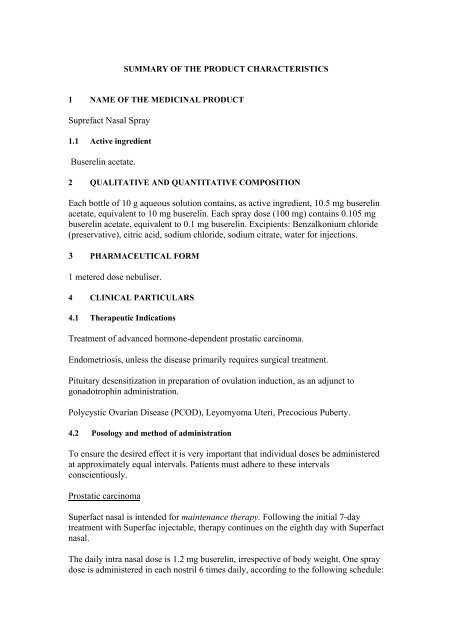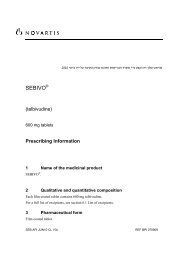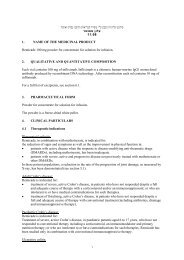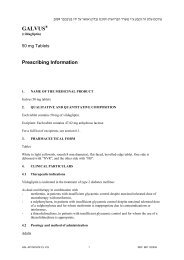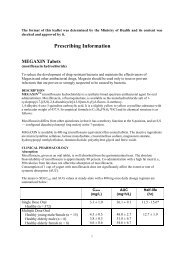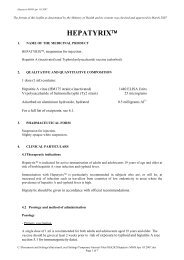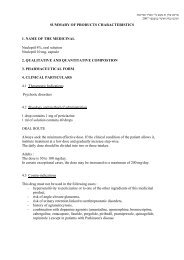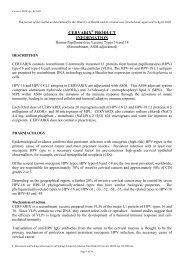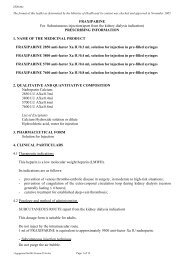Suprefact Nasal Spray Buserelin acetate. Each bottle of 10 g ...
Suprefact Nasal Spray Buserelin acetate. Each bottle of 10 g ...
Suprefact Nasal Spray Buserelin acetate. Each bottle of 10 g ...
Create successful ePaper yourself
Turn your PDF publications into a flip-book with our unique Google optimized e-Paper software.
SUMMARY OF THE PRODUCT CHARACTERISTICS<br />
1 NAME OF THE MEDICINAL PRODUCT<br />
<strong>Suprefact</strong> <strong>Nasal</strong> <strong>Spray</strong><br />
1.1 Active ingredient<br />
<strong>Buserelin</strong> <strong>acetate</strong>.<br />
2 QUALITATIVE AND QUANTITATIVE COMPOSITION<br />
<strong>Each</strong> <strong>bottle</strong> <strong>of</strong> <strong>10</strong> g aqueous solution contains, as active ingredient, <strong>10</strong>.5 mg buserelin<br />
<strong>acetate</strong>, equivalent to <strong>10</strong> mg buserelin. <strong>Each</strong> spray dose (<strong>10</strong>0 mg) contains 0.<strong>10</strong>5 mg<br />
buserelin <strong>acetate</strong>, equivalent to 0.1 mg buserelin. Excipients: Benzalkonium chloride<br />
(preservative), citric acid, sodium chloride, sodium citrate, water for injections.<br />
3 PHARMACEUTICAL FORM<br />
1 metered dose nebuliser.<br />
4 CLINICAL PARTICULARS<br />
4.1 Therapeutic Indications<br />
Treatment <strong>of</strong> advanced hormone-dependent prostatic carcinoma.<br />
Endometriosis, unless the disease primarily requires surgical treatment.<br />
Pituitary desensitization in preparation <strong>of</strong> ovulation induction, as an adjunct to<br />
gonadotrophin administration.<br />
Polycystic Ovarian Disease (PCOD), Leyomyoma Uteri, Precocious Puberty.<br />
4.2 Posology and method <strong>of</strong> administration<br />
To ensure the desired effect it is very important that individual doses be administered<br />
at approximately equal intervals. Patients must adhere to these intervals<br />
conscientiously.<br />
Prostatic carcinoma<br />
Superfact nasal is intended for maintenance therapy. Following the initial 7-day<br />
treatment with Superfac injectable, therapy continues on the eighth day with Superfact<br />
nasal.<br />
The daily intra nasal dose is 1.2 mg buserelin, irrespective <strong>of</strong> body weight. One spray<br />
dose is administered in each nostril 6 times daily, according to the following schedule:
Left nostril right nostril<br />
1 st dose before breakfast 1x 1x<br />
2nd dose after breakfast 1x 1x<br />
3rd dose before midday meal 1x 1x<br />
4th dose after midday meal 1x 1x<br />
5th dose before evening meal 1x 1x<br />
6th dose after evening meal 1x 1x<br />
Adjunctive therapy : About five days before the initiation with <strong>Suprefact</strong> injectable, an<br />
antiandrogen (e.g. cyproterone <strong>acetate</strong>, flutamide or nilutamide) should be<br />
administered at the manufacturer's recommended dosage, and administration then<br />
continued concomitantly over three to four weeks (see under "Special warnings and<br />
precautions" and Adverse effects").<br />
The response to treatment may be monitored by measuring levels <strong>of</strong> testosterone, acid<br />
phosphatase and prostate-specific antigen (PSA) in serum. Testosterone concentration<br />
increases at the start <strong>of</strong> treatment and then decreases over a period <strong>of</strong> 2 weeks,<br />
reaching the castrate range after two to four weeks and remaining at this level for the<br />
duration <strong>of</strong> treatment. The duration <strong>of</strong> treatment is determined by the doctor.<br />
Endometriosis :<br />
The daily dose <strong>of</strong> buserelin is 0.9 mg (equivalent to 9 spray doses <strong>of</strong> 0.1 mg each),<br />
regardless <strong>of</strong> body weight.<br />
The usual duration <strong>of</strong> treatment is six months. It should not be exceeded. Omly a<br />
single course <strong>of</strong> treatment is recommended.<br />
Adjunctive use in ovulation induction:<br />
The initial daily dose <strong>of</strong> <strong>Buserelin</strong> is 0.6 mg (equivalent to 6 spray doses <strong>of</strong> 0.1 mg<br />
each), spread over the waking hours. For some patients it may be necessary to<br />
increase the daily dose to up to 1.2 mg (equivalent to 12 spray doses <strong>of</strong> 0.1 mg each).<br />
Treatment should start in the early follicular phase (day 1) or - provided that early<br />
pregnancy has been excluded (a pregnancy test is recommended if there is any doubt)
- the mid-luteal phase (approx. day 21) <strong>of</strong> the cycle. <strong>Buserelin</strong> should be discontinued<br />
on the first day <strong>of</strong> administration <strong>of</strong> human chorionic gonadotrophin. Ovarian<br />
stimulation with gonadotrophins should only be started after a sufficient reduction in<br />
oestradiol release has been achieved. This takes 2 or 3 weeks in most patients.<br />
The spray doses are administered in each nostril according to the dosage schedules.<br />
The therapeutic effect <strong>of</strong> Superfact nasal can be achieved if the dosage is<br />
conscientiously adhered to. It is, therefore, advisable to administer Superfact nasal<br />
before and after meals. It may also be used at other times provided uniform intervals<br />
are maintained between doses.<br />
For technical reasons a small amount <strong>of</strong> excess solution will remain in the <strong>bottle</strong>.<br />
Special notes<br />
If the spray is used correctly, reliable <strong>of</strong> the active ingredient takes place via the nasal<br />
mucous membrane. <strong>Buserelin</strong> is absorbed even if the patient has a cold. However, the<br />
nose should be blown vigorously before administration in such cases.<br />
4.3 Contraindications<br />
Hypersensitivity to buserelin or any <strong>of</strong> the excipients.<br />
After surgical removal <strong>of</strong> the testes, no further reduction <strong>of</strong> testosterone levels by<br />
Superfact nasal can be expected.<br />
<strong>Buserelin</strong> must not be used in pregnancy.<br />
<strong>Buserelin</strong> passes into breast milk in small amounts. Although negative effects on the<br />
infant have not been observed, breast-feeding should be avoided during treatment <strong>of</strong><br />
endometriosis with <strong>Buserelin</strong> to prevent the infant from ingesting buserelin with<br />
breast milk.<br />
Undiagnosed vaginal bleeding, hypersensitivity to LHRH hormone dependant<br />
neoplasms.<br />
4.4 Special warnings and special precautions for use<br />
In hypertensive patients, blood pressure must be monitored regularly (risk <strong>of</strong> increase<br />
in blood pressure).<br />
In diabetic patients, blood sugar levels must be checked regularly (risk <strong>of</strong><br />
deterioration <strong>of</strong> metabolic control).<br />
Patients with a history <strong>of</strong> depression must be monitored carefully and, if necessary,<br />
treated (risk <strong>of</strong> recurrence or worsening <strong>of</strong> depression).
Prostatic carcinoma<br />
It is strongly recommended that administration <strong>of</strong> an antiandrogen be started as<br />
adjunctive therapy about 5 days before starting treatment.<br />
This therapy must be continued concomitantly with buserelin therapy for 3 to 4 weeks<br />
(see under "Dosage and administration"). After this time, testosterone levels have<br />
usually fallen to within the desired range.<br />
In patients with known metastases (e.g. <strong>of</strong> the spinal column), this adjunctive therapy<br />
is indispensable to prevent initial complications up to and including, for example,<br />
spinal compression and paralysis, arising from a transient activation <strong>of</strong> the tumour and<br />
its metastases (see also under "Adverse effects").<br />
After the initial determination, testosterone levels should be monitored at 3-monthly<br />
intervals. Once testosterone levels have started to fall below their baseline<br />
concentration clinical improvement should start to become apparent. If testosterone<br />
levels do not reach the therapeutic range within 4 weeks (6 weeks as the latest) the<br />
dose schedule should be checked to be sure that it is being followed exactly. A<br />
proportion <strong>of</strong> patients will have tumours that are not sensitive to hormone<br />
manipulation, Absence <strong>of</strong> clinical improvement in the face <strong>of</strong> adequate testosterone<br />
suppression is diagnostic <strong>of</strong> this condition, which will not benefit from therapy with<br />
buserelin.<br />
Endometriosis:<br />
Use <strong>of</strong> oral contraceptives must be discontinued before treatment is started. For<br />
reasons <strong>of</strong> safety, once treatment has begun, alternative, non- hormonal contraception<br />
methods (e.g. condoms) should be substituted in their place.<br />
To exclude pre-existing pregnancy at the start <strong>of</strong> therapy, treatment should begin on<br />
the first or second day <strong>of</strong> menstruation. If there is in any doubt, a pregnancy test is<br />
recommended.<br />
In the later stages <strong>of</strong> treatment, it is unlikely that pregnancy will occur if the<br />
recommended doses are administered regularly. However, if treatment is interrupted,<br />
even for only a few days, ovulation and pregnancy may occur.<br />
If pregnancy does occur, treatment must be discontinued immediately and a physician<br />
informed.<br />
Since a reduction in bone mass cannot be ruled out, the attending physician must<br />
conduct a careful risk-benefit assessment before repeated courses <strong>of</strong> therapy.<br />
Adjunctive use in ovulation induction;<br />
A pregnancy test should be performed before treatment is started.<br />
In in-vitro fertilization, induction <strong>of</strong> ovulation must be performed under close medical<br />
supervision.
When gonadotrophins are used together with <strong>Buserelin</strong>, the risk <strong>of</strong> ovarian<br />
hyperstimulation syndrome is higher than with use <strong>of</strong> gonadotrophins alone.<br />
Possible clinical signs <strong>of</strong> this syndrome include: abdominal pain, feeling <strong>of</strong> abdominal<br />
tension, increased abdominal girth, occurrence <strong>of</strong> ovarian cysts, nausea, vomiting, as<br />
well as massive enlargement <strong>of</strong> the ovaries, dyspnoea, diarrhoea, oliguria,<br />
haemoconcentration, hypercoagulability. Pedicle torsion or rupture <strong>of</strong> the ovary may<br />
lead to an acute abdomen. Severe thromboembolic events may also occur. Ovarian<br />
hyperstimulation syndrome can be fatal.<br />
<strong>Each</strong> stimulation cycle must be monitored carefully to permit early identification <strong>of</strong><br />
affected patients. It may necessary to omit treatment with human chorionic<br />
gonadotrophin (hCG).<br />
4.5 Effects on ability to drive and use machines<br />
Certain adverse effects (e.g. dizziness) may impair the ability to concentrate and react,<br />
and, therefore, constitute a risk in situations where these abilities are <strong>of</strong> particular<br />
importance (e.g. operating a vehicle or machinery).<br />
4.6 Interaction with other medicinal products and other forms <strong>of</strong> interaction<br />
During treatment with buserelin, the effect <strong>of</strong> antidiabetic agents may be attenuated<br />
(see also under "Adverse effects").<br />
If nasal decongestants are being used concurrently, they should be administered at<br />
least 30 minutes after buserelin.<br />
Endometriosis:<br />
In concomitant treatment with sexual hormones ("add back"), the dosage is to be<br />
selected so as to ensure that the overall therapeutic effect is not affected.<br />
4.7 Undesirable effects<br />
Prostatic carcinoma<br />
At the start <strong>of</strong> treatment, a transient rise in the serum testosterone levels usually<br />
develops and may lead to a temporary activation <strong>of</strong> the tumour with secondary<br />
reactions such as:<br />
- Occurrence or worsening <strong>of</strong> bone pain in patients with bone metastases.<br />
- Signs <strong>of</strong> neurologic deficit due to tumour compression with e.g. muscle<br />
weakness in the legs.<br />
- Impaired micturition, hydronephrosis or Iymphostasis.<br />
- Thrombosis with pulmonary embolism.<br />
Such reactions can be largely avoided when antiandrogen is given concomitantly in<br />
the initial phase <strong>of</strong> buserelin treatment (see also under "Special warnings and<br />
precautions").
Even then, however, a mild but transient increase in tumour pain as well as a<br />
deterioration in general well- being may develop in some patients.<br />
Additionally, as a result <strong>of</strong> hormone deprivation, hot flushes and loss <strong>of</strong> potency or<br />
libido occur in most patients. Mild oedemas <strong>of</strong> the ankles and lower leg may occur as<br />
may, occasionally, usually painless gynaecomastia.<br />
Endometriosis and Preparation <strong>of</strong> ovulation induction:<br />
Treatment with <strong>Buserelin</strong> inhibits oestrogen production. In addition to the intended<br />
therapeutic effects, this may lead also to adverse effects (dose-dependent); i.e., where<br />
buserelin for preparation for ovulation induction is used at low dosage, these effects<br />
occur less frequently and are less pronounced that in the treatment <strong>of</strong> endometriosis.<br />
Uterine bleeding ("period"), as a manifestation <strong>of</strong> inhibited oestrogen production,<br />
occurs in most patients, usually in the first weeks <strong>of</strong> treatment. Occasionally,<br />
however, it may occur in the later stages <strong>of</strong> treatment.<br />
Recovery <strong>of</strong> pituitary-gonadal function usually occurs within 8 weeks <strong>of</strong><br />
discontinuing treatment. In addition, menopausal-like symptoms, such as hot flushes,<br />
increased sweating, vaginal dryness, pain during sexual intercourse, decreased libido,<br />
and (may be severe in some patients) after several months' treatment - a decrease in<br />
bone mass, may occur.<br />
Further adverse effects not clearly attributable to hormone deprivation are: increase or<br />
decrease in breast size (with breast tenderness), splitting nails, acne, dry skin;<br />
occasionally, vaginal discharge and oedema on the face and extremities may also<br />
occur.<br />
In addition, lactation, pain in the stomach or lower abdomen, abnormal sensations<br />
(especially in the arms or legs) may occur, as may dryness <strong>of</strong> the eyes (possibly<br />
leading to eye irritation in patients who wear contact lenses).<br />
Endometriosis:<br />
Ovarian cysts may develop in the initial phase <strong>of</strong> treatment.<br />
Preparation <strong>of</strong> ovulation induction:<br />
In-vitro fertilization/embryo transfer programs and similar assisted reproduction<br />
procedures carry inherent risks, e.g. increased occurrence <strong>of</strong> ectopic pregnancies,<br />
miscarriages or multiple pregnancies. These risks are also present when buserelin is<br />
used as adjunctive therapy. The fact that follicle recruitment may be increased under<br />
buserelin treatment (especially in the case <strong>of</strong> polycystic ovaries) may, however, in<br />
some patients also represent a desirable effect.<br />
In the initial phase <strong>of</strong> treatment with <strong>Buserelin</strong>, ovarian cyst may develop; however,<br />
no negative effects on the course <strong>of</strong> stimulation has been reported so far.
Combined use with gonadotrophins may carry a higher risk <strong>of</strong> ovarian<br />
hyperstimulation syndrome (OHSS) than the use <strong>of</strong> gonadotropins alone (see also<br />
under "Special warnings and precautions").<br />
Applies to all indications:<br />
Very rare cases <strong>of</strong> pituitary adenomas were reported during treatment with LHRH<br />
agonists including buserelin.<br />
<strong>Buserelin</strong> treatment may lead to:<br />
- increase or decrease in scalp or body hair.<br />
- increase in blood pressure in hypertensive patients.<br />
- hypersensitivity reactions. These may become manifest as, e.g. reddening <strong>of</strong><br />
the skin, itching, skin rashes (including urticaria) and allergic asthma with<br />
dyspnoea but may also, in isolated cases, lead to anaphylactic/anaphylactoid<br />
shock.<br />
- reduction in glucose tolerance (possible deterioration <strong>of</strong> metabolic control in<br />
diabetic patients).<br />
- changes in blood lipids; increase in serum levels <strong>of</strong> liver enzymes (e.g.<br />
transaminases) or in bilirubin; thrombopenia and leucopenia.<br />
- headaches in up to <strong>10</strong>% <strong>of</strong> patients receiving buserelin. These tend to occur at<br />
the start <strong>of</strong> treatment and are seldom severe enough to necessitate the<br />
discontinuation <strong>of</strong> buserelin therapy, palpitations, nervousness, sleep<br />
disturbances, tiredness, drowsiness, disturbances <strong>of</strong> memory and<br />
concentration, emotional instability, feelings <strong>of</strong> anxiety. In rare cases,<br />
depression may develop or existing depression may worsen.<br />
- dizziness, tinnitus, hearing disorders, impaired vision (e.g. blurred vision),<br />
feeling <strong>of</strong> pressure behind the eyes.<br />
- nausea, vomiting, increased thirst, diarrhoea, constipation, changes in appetite,<br />
weight changes (increase or decrease).<br />
- musculoskeletal discomfort and pain (including shoulder pain/stiffness in<br />
women). The use <strong>of</strong> LHRH-agonists may be associated with decreased bone<br />
density and may lead to osteoporosis and an increased risk <strong>of</strong> bone fracture.<br />
The risk <strong>of</strong> skeletal fracture increases with the duration <strong>of</strong> therapy.<br />
- irritation <strong>of</strong> the mucosae <strong>of</strong> the nasal and pharyngeal cavity; this may lead to<br />
nosebleeds, hoarseness or disturbances <strong>of</strong> smell and taste.<br />
4.8 Emergency measures to be taken in the event <strong>of</strong> anaphylactic shock<br />
Generally, the following emergency procedure is recommended: At the first signs<br />
(sweating, nausea, cyanosis), perform venous cannulation. In addition to the usual<br />
emergency measures, ensure that the patient remains lying down, with the legs raised<br />
and airways patent.<br />
Emergency drug therapy:<br />
Immediately epinephrine (adrenaline) i.v.: In the first instance, slowly inject 1 ml <strong>of</strong> a<br />
solution containing 0.1 mg epinephrine per ml while monitoring pulse and blood<br />
pressure (watch for disturbances in cardiac rhythm). Repeat as required. Then volume
substitution i.v., e.g. plasma expanders, human albumin, balanced electrolyte solution.<br />
Subsequently glucocorticoids i. v., e.g. 250 - <strong>10</strong>00 mg methylprednisolone. Repeat as<br />
required.<br />
The dosage recommendations refer to adults <strong>of</strong> normal weight. In children, the<br />
reduction <strong>of</strong> dose should be in relation to body weight. Other therapeutic measures,<br />
e.g. artificial respiration, oxygen inhalation, antihistaminics.<br />
4.9 Overdose<br />
Overdose may lead to signs and symptoms such as asthenia, headache, nervousness,<br />
hot flushes, dizziness, nausea, abdominal pain, oedemas <strong>of</strong> the lower extremities, and<br />
mastodynia.<br />
Therapy for overdose is directed to the symptoms.<br />
5 PHARMACOLOGICAL PROPERTIES<br />
5.1 Pharmacodynamic properties<br />
<strong>Buserelin</strong> is an analogue <strong>of</strong> the natural gonadotrophin-releasing hormone<br />
(gonadorelin; GnRH) with enhanced biological activity. After repeated administration<br />
<strong>of</strong> buserelin, the secretion <strong>of</strong> gonadotrophins and gonadal steroids is significantly<br />
inhibited.<br />
The pharmacological effect is attributable to the down-regulation <strong>of</strong> pituitary LH-RH<br />
receptors.<br />
In male individuals the elimination <strong>of</strong> gonadotrophin release results in a lasting<br />
reduction in the synthesis and secretion <strong>of</strong> testosterone. In female individuals the<br />
elimination <strong>of</strong> pulsatile gonadotrophin release reliably inhibits the secretion <strong>of</strong><br />
oestrogen.<br />
The suppressive effect <strong>of</strong> buserelin on the secretion <strong>of</strong> gonadal steroids depends on<br />
the daily dose, the frequency <strong>of</strong> application and the duration <strong>of</strong> treatment.<br />
Even when the serum level <strong>of</strong> buserelin is below the detection limit, gonadotrophin<br />
release is preserved because <strong>of</strong> sustained binding to the receptors <strong>of</strong> the anterior lobe<br />
<strong>of</strong> the pituitary gland (approx. 3 hours).<br />
While gonadotrophin release is inhibited during long-term treatment with buserelin,<br />
the secretion <strong>of</strong> the other pituitary hormones (growth hormone, prolactin, ACTH,<br />
TSH) is not directly influenced. However, oestrogen deficiency may lead to decreased<br />
secretion <strong>of</strong> growth hormone and prolactin. The secretion <strong>of</strong> adrenal steroids remains<br />
unchanged.<br />
Applies only to the indication "prostatic carcinoma":<br />
In terms <strong>of</strong> the complete inhibition <strong>of</strong> testicular testosterone synthesis, buserelin is<br />
equally as effective as orchiectomy in the treatment <strong>of</strong> prostatic carcinoma. Compared<br />
with orchiectomy, buserelin <strong>of</strong>fers the advantage <strong>of</strong> reversibility and reduced<br />
psychological stress for the patient.
6 PHARMACEUTICAL PARTICULARS<br />
<strong>Buserelin</strong> is water-soluble; when administered by subcutaneous injection it is reliably<br />
absorbed.<br />
If administered correctly by the nasal route, it is absorbed via the nasal mucosa in<br />
such a way that sufficiently high plasma levels are guaranteed. The biological activity<br />
<strong>of</strong> buserelin was not impaired even after the induction <strong>of</strong> histamine rhinitis in test<br />
subjects.<br />
The nasal absorption <strong>of</strong> buserelin from buserelin nasal solution is 1 to 3%. After<br />
subcutaneous injection <strong>of</strong> 200 µg, buserelin is 70% bioavailable; in contrast, after oral<br />
administration, buserelin is ineffective.<br />
<strong>Buserelin</strong> accumulates preferentially in the liver and kidneys as well as in the anterior<br />
pituitary lobe, the biological target organ.<br />
The elimination half-life is approx. 50 to 80 minutes following intravenous<br />
administration, 80 minutes after subcutaneous administration and approx. 1 to 2 hours<br />
after intranasal administration.<br />
<strong>Buserelin</strong> circulates in serum predominantly in intact, active form. Protein binding is<br />
approx. 15%. <strong>Buserelin</strong> and inactive buserelin metabolites are excreted via the renal<br />
and the biliary route. The serum concentration and the excretion <strong>of</strong> buserelin in the<br />
urine show the same time pr<strong>of</strong>ile. In man, approx. 50% <strong>of</strong> buserelin excreted in the<br />
urine is intact.<br />
<strong>Buserelin</strong> is metabolized by peptidases (pyroglutamyl peptidase and chymotrypsinlike<br />
endopeptidases) in the liver and kidneys as well as in the gastrointestinal tract and<br />
by this means inactivated. In the pituitary gland, receptor-bound buserelin is<br />
inactivated by membrane-located enzymes.<br />
A small proportion <strong>of</strong> the dose <strong>of</strong> buserelin is secreted into the breast milk. According<br />
to present clinical experience these amounts have no hormonal effect on the infant.<br />
6.1 Non-Clinical Safety Data<br />
No signs <strong>of</strong> toxicity or histopathological changes were detected in long-term<br />
pharmacology and toxicology studies in rats, dogs and monkeys; the endocrine effects<br />
observed were restricted to the gonads.<br />
Pituitary adenoma occurs during long-term treatment in rats; this phenomenon has not<br />
been found in dogs and monkeys.<br />
• Reproduction toxicology<br />
<strong>Buserelin</strong> has no embryotoxic or teratogenic effects. No maternal toxicity or fetotoxic<br />
effects relevant to humans have been observed in any animal studies.<br />
• Immunotoxicology<br />
In animals and humans there was no antibody formation to buserelin, even during<br />
long-term treatment.<br />
• Mutagenicity<br />
<strong>Buserelin</strong> showed no mutagenic potential in any <strong>of</strong> the studies performed.<br />
• Neoplastic potential<br />
<strong>Buserelin</strong> showed no carcinogenic potential in any <strong>of</strong> the studies performed.<br />
• Local tolerance<br />
The local tolerance <strong>of</strong> buserelin after injection or after application to mucosa in<br />
aqueous solutions is excellent. The local tolerance <strong>of</strong> buserelin implants is good, and<br />
tissue reactions at the injection site are minor.
6.2 Special precautions for storage<br />
Store between +2° and +25°C. Do not allow to freeze.<br />
Once opened, the <strong>bottle</strong>s may be stored at room temperature.<br />
Keep medicines out <strong>of</strong> the reach <strong>of</strong> children.<br />
6.3 Instructions for use and handling, and disposal (if appropriate)<br />
This preparation will only be effective if the instructions for use in this leaflet are<br />
followed carefully.<br />
1. Remove screw cap from <strong>bottle</strong>.<br />
2. Remove metered-dose nebulizer from plastic container and take <strong>of</strong>f both<br />
protective caps - one white, the other transparent.<br />
3. Screw nebulizer onto <strong>bottle</strong>.<br />
4. Before first application only, holding <strong>bottle</strong> upright, work pump vigorously<br />
about <strong>10</strong> times to fill the system with solution and guarantee emission <strong>of</strong> a<br />
uniform spray.<br />
5. Keeping <strong>bottle</strong> upright and bending head slightly forwards, spray solution into<br />
nostril. If necessary, blow nose before administering the solution.<br />
6. Always keep nebulizer screwed on <strong>bottle</strong>. Replace protective cap after each<br />
use.<br />
Please note: To avoid wasting <strong>bottle</strong> contents, perform preliminary pumping<br />
prior to first application only.<br />
Manufacturer: Aventis Pharma, Germany.<br />
Importer: Aventis Pharma Ltd. 1 Haomanut st. P.O.B. 8090, Netanya 42170, Israel.<br />
."<br />
רשואו קדבנ ונכותו תואירבה דרשמ י"<br />
ע עבקנ הז ןולע טמרופ"


